Item 1: Report to Shareholders| Personal Strategy Growth Fund | November 30, 2007 |
The views and opinions in this report were current as of November 30, 2007. They are not guarantees of performance or investment results and should not be taken as investment advice. Investment decisions reflect a variety of factors, and the managers reserve the right to change their views about individual stocks, sectors, and the markets at any time. As a result, the views expressed should not be relied upon as a forecast of the fund’s future investment intent. The report is certified under the Sarbanes-Oxley Act, which requires mutual funds and other public companies to affirm that, to the best of their knowledge, the information in their financial reports is fairly and accurately stated in all material respects.
REPORTS ON THE WEB
Sign up for our E-mail Program, and you can begin to receive updated fund reports and prospectuses online rather than through the mail. Log in to your account at troweprice.com for more information.
Manager’s LetterFellow Shareholders
Several months of considerable volatility created a turbulent environment for investors. For the six-month period that ended November 30, 2007, stocks lost ground and, despite some trying periods in the credit markets, bonds were able to post gains. Healthy corporate earnings reports could not offset concerns about the extent of the problems in the U.S. subprime market, a weakening U.S. economy, and rising oil prices, all of which created an uncertain environment for equities. Two Federal Reserve interest rate cuts could not calm the bond markets’ roiled waters, but most bonds—with the exception of high-yield issues—were able to post positive returns for the six-month period. Non-U.S. stocks performed well, and the weakened dollar boosted returns for U.S. investors. The Personal Strategy Funds generated mixed returns for the six-month period ended November 30, 2007.
MARKET ENVIRONMENT
The U.S. economy expanded vigorously at an annualized rate of 4.9% in the third quarter, according to the most recent estimates. However, growth is expected to slow dramatically in the months ahead due to the deepening downturn in residential real estate, a slower pace of job growth, rising energy prices, and generally stricter bank lending standards.
As the fallout of subprime mortgage defaults and delinquencies spread from mortgage companies to big Wall Street firms and major commercial banks, liquidity in the financial markets, particularly in the asset-backed commercial paper market, quickly evaporated during the summer and again in November. The credit market problems prompted investors to seek out the relative safety of U.S. Treasury securities.
The Federal Reserve responded to the summer’s liquidity crisis by reducing the discount rate—the interest rate paid by financial institutions that borrow from the central bank—and adding billions of dollars to the banking system on several occasions starting in mid-August. The central bank also twice reduced the fed funds target rate, used to price overnight bank loans and to benchmark prime lending rates, to 4.50%, where it remained at the end of the reporting period. These were the first changes in the fed funds rate since June 2006 and the first rate cuts in more than four years. Despite signs of some emerging inflationary pressures, the market expected the Fed to cut the rate again in December.

As shown in the graph, Treasury bill yields—which tend to track the federal funds target rate—fell sharply in the last few months. Intermediate- and long-term interest rates fell to a lesser extent. The Treasury yield curve, which depicts the relationship between the yields and maturities of government bonds, steepened significantly, as investors anticipated additional short-term interest rate cuts in the months ahead.
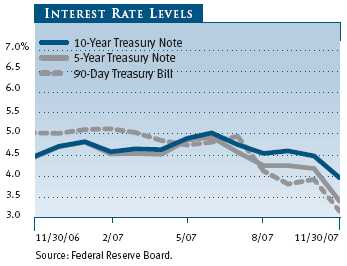
U.S. stocks were volatile in the last six months—falling in July, rising in August, peaking in October, and then declining in November. At various times during the period, the market climbed on hearing an encouraging news item only to fall precipitously on the next day’s discouraging news. However, weaker third-quarter earnings reports, the abrupt end to the boom in private-equity leveraged buyouts, and the expectation that housing weakness and rising energy costs would dampen consumer activity gradually undermined investor confidence. Large-cap shares held up better than their smaller brethren: The S&P 500 Index returned about -3% versus about -9% for the small-cap Russell 2000 Index. As measured by various Russell indexes, growth stocks held up much better than value.
U.S. bonds produced solid returns in the last six months, as rising prices—in response to falling interest rates—enhanced returns from income. In the investment-grade universe, Treasuries did best. Gains among mortgage-backed securities and high-quality corporate bonds were more modest. High-yield issues declined as investors shunned assets with higher credit risks. The Lehman Brothers U.S. Aggregate Index, a broad measure of the taxable, domestic, investment-grade bond market, returned 5.32% in the last six months.
Non-U.S. stocks outperformed their domestic counterparts, and foreign currencies rose against the U.S. dollar, augmenting returns in dollar terms. Emerging market equities generated the strongest results, especially in Asia. Among developed markets, Europe outperformed Japan. The MSCI EAFE Index, a measure of mostly large-cap stocks in Europe, Australia, and the Far East, returned about 3%. 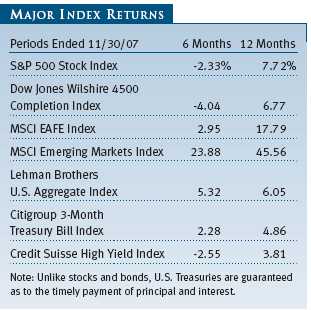
PERFORMANCE AND STRATEGY REVIEW
Asset allocations for the Personal Strategy Funds can vary by 10 percentage points above or below the benchmarks that have been established for each fund, and the funds’ investment committee meets monthly to adjust the weightings of stocks, bonds, and money market securities within the appropriate ranges for each fund. Economic fundamentals and market conditions drive these allocation changes.
For the last six months, we have maintained an overweight to stocks. With bonds outperforming stocks during that period, the emphasis on stocks hurt the portfolios’ performance. More recently, in light of the lower expectations for U.S. economic growth, we have been trimming our U.S. equity allocation and adding to our non-U.S. equity positions. As mentioned in the last report, the asset allocation committee decided to increase its non-U.S. equity allocation to better reflect the growing share of non-U.S. markets within the global investment universe. The committee also decided to add an emerging markets allocation by dedicating a portion of the funds’ international holdings to the T. Rowe Price Institutional Emerging Markets Equity Fund. During the last six months, we began to implement both policies.
With international stocks outperforming domestic stocks during this period, our strategic decision to increase allocation within our equity position to international stocks—and initiating and building the emerging markets exposure within that group—was a positive contributor. We maintained our allocation to cash. The investment-grade bond allocation was incrementally higher than six months ago, which helped us to better weather the summer’s bond market turmoil. Since the Federal Reserve’s two cuts in its target interest rates, bond values climbed. (Bond prices and yields move in opposite directions.)
Among our stock holdings, we maintained an overweight to high-quality large-cap growth stocks, but we have reduced the overweight slightly. During the past year, large-cap growth stocks outperformed large-cap value, and our positioning augmented our performance. We believe the market has entered a period of slowing earnings growth and that investors are likely to pay a premium for those high-quality large-caps whose earnings grow faster than the market. Following a prolonged period of outperformance, we trimmed our already underweight allocation to small-cap companies, whose valuations are no longer as compelling.
Within our fixed-income holdings, as mentioned earlier, over the past 12 months we have increased our allocation to non-U.S. bonds, which have benefited from the weaker U.S. dollar.
Strong gains in non-U.S. stock markets helped extend their multiyear rally into 2007 and boosted the funds’ performance for the period. In the EAFE-related markets (Europe, Australasia, and Far East), we believe valuations are reasonable. Even though economic growth in the developed markets of Europe and Japan has slowed down in the last six months, many companies have been able to increase their sales to booming emerging markets and use productivity gains to squeeze more earnings out of their revenue growth.
Among our major equity holdings, we find General Electric attractive because its core industrial, health care, and financial businesses remain strong and have strong global sales. In addition, its financial services segment is now poised for strong international growth. Microsoft, the software giant, is well positioned for the next year with strong sales of server software and the widespread corporate adoption of its Vista operating system. Schlumberger, the international oil services company, has seen a drop in U.S. sales, but it has more than made up the loss through sales of its oil drilling and seismic services to oil companies outside the U.S. (Please refer to each fund’s portfolio of investments for a complete listing of holdings and the amount each represents in each portfolio.)
Personal Strategy Income FundThe Personal Strategy Income Fund’s investment objective is to generate the highest total return consistent with an emphasis on income first and capital appreciation second. The typical mix of securities for the fund is 40% stocks, 40% bonds, and 20% money market securities, although allocations can vary by as much as 10 percentage points above or below these levels.
The Personal Strategy Income Fund posted a gain for the 6-month period ended November 30, 2007, as shown in the table. The fund was in line with the combined index portfolio but underperformed the Lehman Brothers U.S. Aggregate Index. Our heavier exposure to stocks relative to bonds hurt performance, but our increased allocation to international stocks was beneficial because non-U.S. equities outperformed U.S. stocks.

At the end of the period, 44.2% of the fund’s net assets were in bonds, representing an increase since our last report. Stock holdings were 42.7%, slightly less than six months ago. Cash has ended at 13.1% at the end of the period. Over the last six months, we increased our target allocation to international stocks and reduced the target allocation to U.S. stocks as part of our long-term strategic plan of increasing the portfolio’s international exposure. We also increased our target allocations to investment-grade and high-yield bonds.
Personal Strategy Balanced Fund
The Personal Strategy Balanced Fund’s investment objective is to generate the highest total return consistent with an equal emphasis on income and capital appreciation. The typical asset mix of securities is 60% stocks, 30% bonds, and 10% cash, although allocations can vary by as much as 10 percentage points above or below these levels. This asset allocation entails higher risk but also a higher potential return over the long term than the Personal Strategy Income Fund.
The Personal Strategy Balanced Fund posted a gain for the six-month period ended November 30, 2007, as shown in the table. The fund outperformed the combined index portfolio and the Merrill Lynch-Wilshire Capital Market Index for the six-month period. The portfolio’s international equity allocation had a strong showing and contributed to the portfolio’s performance. Large-cap value stocks struggled during the period, but the portfolio was underweighted in this sector, which helped our performance. 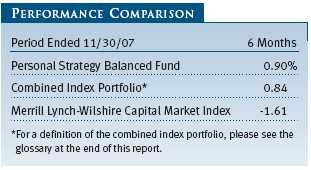
We continue to underweight fixed income, but over the past six months, we increased the target allocation. The fund’s fixed-income allocation ended the reporting period at 37.2%, slightly more than six months ago but less than our neutral level of 40%. Our allocation to cash finished at 3.6%. As mentioned in the Performance and Strategy Review section, we still maintain a relatively heavier stock allocation (62.8% compared with a neutral weighting of 60.0%). Among U.S. stocks, we maintain an underweight to small-caps. As mentioned earlier, we have been adding to our target allocations of international and emerging markets stocks during this reporting period. The strong performance of international equities benefited our performance.
Personal Strategy Growth Fund
The Personal Strategy Growth Fund’s investment objective is to generate the highest total return consistent with a primary emphasis on capital growth and a secondary emphasis on income. The typical asset mix is 80% stocks and 20% bond and money market securities, although allocations can vary by as much as 10 percentage points above or below these levels. This asset allocation entails higher risk but also a higher potential return over the long term than the Personal Strategy Income and the Personal Strategy Balanced Funds.
The Personal Strategy Growth Fund posted a slight loss for the six-month period ended November 30, 2007, as shown in the table. The fund’s performance was in line with the combined index portfolio, but it outperformed the Merrill Lynch-Wilshire Capital Market Index. The portfolio’s allocation to international and emerging markets helped contribute to absolute results.
We made a few changes in the fund’s stock and bond allocations. Since the fund’s primary objective is growth, we maintain a large position in equities—83.8% at the end of this period, which is about what our weight was six months ago. As a result of our decision to shift a small allocation from stocks to bonds, our bond position of 15.7% has increased from the 15.3% allocation at the end of the last reporting period. As mentioned in the Performance and Strategy Review section, we maintain an overweight in stocks versus bonds. Among U.S. stocks, we maintain an underweight to small-caps. As mentioned earlier, we have been adding to our target allocations of international and emerging markets stocks during this reporting period. The strong performance of international equities benefited our performance.
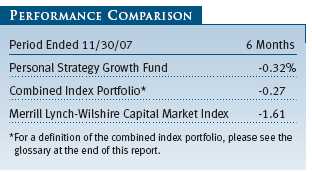
OUTLOOK
As we write this letter, markets around the world are experiencing turbulence. Although we do not necessarily believe that equity markets will outperform fixed income for the next three to six months, we believe the environment remains supportive for equities, particularly at current valuation levels. Profit growth will likely decelerate as slower U.S. economic growth and higher commodities and labor costs take their toll on corporate earnings growth. We believe that large-cap underperformance has created attractive valuations, and in an environment of slower earnings growth, those quality large-cap growth companies that offer consistent earnings increases should command a premium. Our investment approach continues to incorporate a disciplined strategy, broad diversification, and a long-term focus. Whatever the near term holds, we believe that shareholders will be well served by the funds’ fundamental commitment to diversification across asset classes.
Respectfully submitted,

Edmund M. Notzon III
Chairman of the funds’ Investment Advisory Committee
December 13, 2007
The committee chairman has day-to-day responsibility for managing the portfolios and works with committee members in developing and executing the funds’ investment programs.
RISKS OF INVESTINGAs with all stock and bond mutual funds, each fund’s share price can fall because of weakness in the stock or bond markets, a particular industry, or specific holdings. Stock markets can decline for many reasons, including adverse political or economic developments, changes in investor psychology, or heavy institutional selling. The prospects for an industry or company may deteriorate because of a variety of factors, including disappointing earnings or changes in the competitive environment. In addition, the investment manager’s assessment of companies held in a fund may prove incorrect, resulting in losses or poor performance even in rising markets.
Bonds are subject to interest rate risk, the decline in bond prices that usually accompanies a rise in interest rates, and credit risk, the chance that any fund holding could have its credit rating downgraded or that a bond issuer will default (fail to make timely payments of interest or principal), potentially reducing the fund’s income level and share price. High-yield corporate bonds could have greater price declines than funds that invest primarily in high-quality bonds. Companies issuing high-yield bonds are not as strong financially as those with higher credit ratings, so the bonds are usually considered speculative investments.
Funds that invest overseas may carry more risk than funds that invest strictly in U.S. assets. Risks can result from varying stages of economic and political development; differing regulatory environments, trading days, and accounting standards; and higher transaction costs of non-U.S. markets. Non-U.S. investments are also subject to currency risk, or a decline in the value of a foreign currency versus the U.S. dollar, which reduces the dollar value of securities denominated in that currency.
GLOSSARY
Combined index portfolios: Unmanaged portfolios composed of the following underlying indexes:
• Personal Strategy Income—40% stocks (33.5% Dow Jones Wilshire 5000 Composite Index, 6.5% MSCI EAFE Index), 40% bonds (Lehman Brothers U.S. Aggregate Index), and 20% money market securities (Citigroup 3-Month Treasury Bill Index).
• Personal Strategy Balanced—60% stocks (50.25% Dow Jones Wilshire 5000 Composite Index, 9.75% MSCI EAFE Index), 30% bonds (Lehman Brothers U.S. Aggregate Index), and 10% money market securities (Citigroup 3-Month Treasury Bill Index).
• Personal Strategy Growth—80% stocks (67% Dow Jones Wilshire 5000 Composite Index, 13% MSCI EAFE Index) and 20% bonds (Lehman Brothers U.S. Aggregate Index).
Duration: The average time (expressed in years) it takes investors to receive the present value of the future cash flows on their investment. It is used to measure the sensitivity of bond prices to interest rate changes (the shorter the duration, the less the bond’s price will rise or fall in value when interest rates change). Duration is affected by maturity, the coupon, and the time interval between payments. Other things being equal, a bond with a higher coupon will have a shorter duration, while zero-coupon bonds have the longest.
Lehman Brothers U.S. Aggregate Index: An unmanaged index that tracks investment-grade corporate and government bonds.Merrill Lynch-Wilshire Capital Market Index: A market capitalization-weighted index including the Wilshire 5000 and Merrill Lynch High Yield II and Domestic Master indexes.
MSCI EAFE Index: An unmanaged index that tracks the stocks of about 1,000 companies in Europe, Australasia, and the Far East (EAFE).
Russell 2000 Index: Consists of the smallest 2,000 companies in the Russell 3000 Index. Performance is reported on a total return basis.
S&P 500 Index: An unmanaged index that tracks the stocks of 500 primarily large-cap U.S. companies.
Wilshire 5000 Index: A widely watched total market index that attempts to track the direction of most of the widely traded shares on U.S. exchanges, including small-, mid-, and large-cap issues.
Yield curve: A graphic depiction of the relationship between yields and maturity dates for a set of similar securities, such as Treasuries or municipal securities. Yield curves typically slope upward, indicating that longer maturities offer higher yields. When the yield curve is flat, there is little or no difference between the yields offered by shorter- and longer-term securities.

Performance and Expenses
This chart shows the value of a hypothetical $10,000 investment in the fund over the past 10 fiscal year periods or since inception (for funds lacking 10-year records). The result is compared with benchmarks, which may include a broad-based market index and a peer group average or index. Market indexes do not include expenses, which are deducted from fund returns as well as mutual fund averages and indexes.
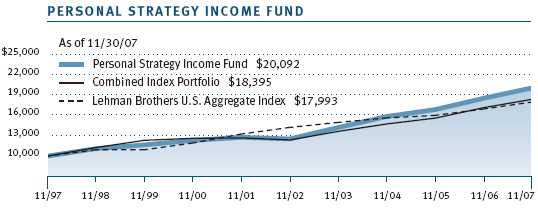
| AVERAGE ANNUAL COMPOUND TOTAL RETURN |
This table shows how the fund would have performed each year if its actual (or cumulative) returns for the periods shown had been earned at a constant rate.
This chart shows the value of a hypothetical $10,000 investment in the fund over the past 10 fiscal year periods or since inception (for funds lacking 10-year records). The result is compared with benchmarks, which may include a broad-based market index and a peer group average or index. Market indexes do not include expenses, which are deducted from fund returns as well as mutual fund averages and indexes.
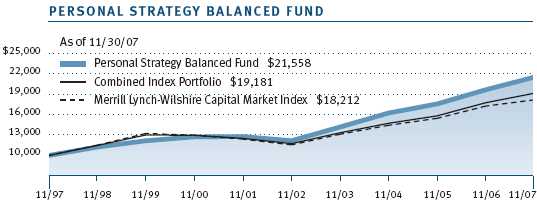
| AVERAGE ANNUAL COMPOUND TOTAL RETURN |
This table shows how the fund would have performed each year if its actual (or cumulative) returns for the periods shown had been earned at a constant rate.
This chart shows the value of a hypothetical $10,000 investment in the fund over the past 10 fiscal year periods or since inception (for funds lacking 10-year records). The result is compared with benchmarks, which may include a broad-based market index and a peer group average or index. Market indexes do not include expenses, which are deducted from fund returns as well as mutual fund averages and indexes.
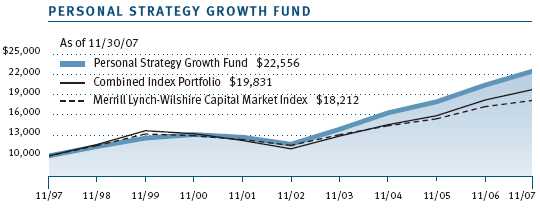
| AVERAGE ANNUAL COMPOUND TOTAL RETURN |
This table shows how the fund would have performed each year if its actual (or cumulative) returns for the periods shown had been earned at a constant rate.
As a mutual fund shareholder, you may incur two types of costs: (1) transaction costs, such as redemption fees or sales loads, and (2) ongoing costs, including management fees, distribution and service (12b-1) fees, and other fund expenses. The following example is intended to help you understand your ongoing costs (in dollars) of investing in the fund and to compare these costs with the ongoing costs of investing in other mutual funds. The example is based on an investment of $1,000 invested at the beginning of the most recent six-month period and held for the entire period.
Actual Expenses
The first line of the following table (“Actual”) provides information about actual account values and expenses based on the fund’s actual returns. You may use the information in this line, together with your account balance, to estimate the expenses that you paid over the period. Simply divide your account value by $1,000 (for example, an $8,600 account value divided by $1,000 = 8.6), then multiply the result by the number in the first line under the heading “Expenses Paid During Period” to estimate the expenses you paid on your account during this period.
Hypothetical Example for Comparison Purposes
The information on the second line of the table (“Hypothetical”) is based on hypothetical account values and expenses derived from the fund’s actual expense ratio and an assumed 5% per year rate of return before expenses (not the fund’s actual return). You may compare the ongoing costs of investing in the fund with other funds by contrasting this 5% hypothetical example and the 5% hypothetical examples that appear in the shareholder reports of the other funds. The hypothetical account values and expenses may not be used to estimate the actual ending account balance or expenses you paid for the period.
Note: T. Rowe Price charges an annual small-account maintenance fee of $10, generally for accounts with less than $2,000 ($500 for UGMA/UTMA). The fee is waived for any investor whose T. Rowe Price mutual fund accounts total $25,000 or more, accounts employing automatic investing, and IRAs and other retirement plan accounts that utilize a prototype plan sponsored by T. Rowe Price (although a separate custodial or administrative fee may apply to such accounts). This fee is not included in the accompanying table. If you are subject to the fee, keep it in mind when you are estimating the ongoing expenses of investing in the fund and when comparing the expenses of this fund with other funds.
You should also be aware that the expenses shown in the table highlight only your ongoing costs and do not reflect any transaction costs, such as redemption fees or sales loads. Therefore, the second line of the table is useful in comparing ongoing costs only and will not help you determine the relative total costs of owning different funds. To the extent a fund charges transaction costs, however, the total cost of owning that fund is higher.
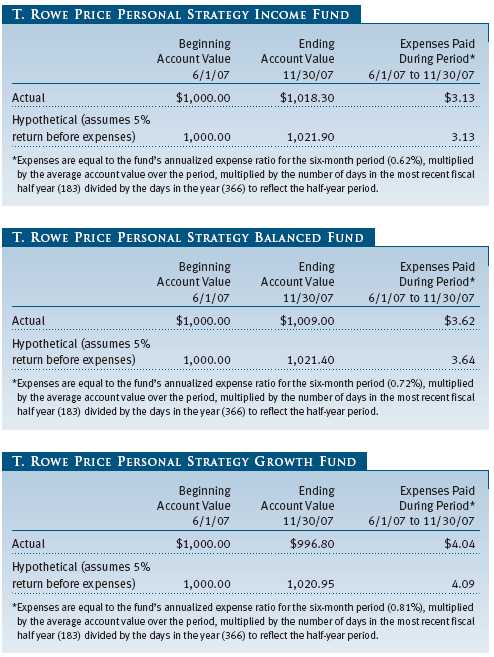
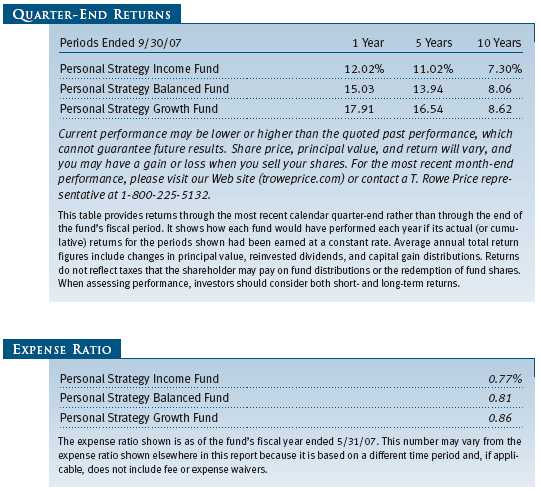
Unaudited
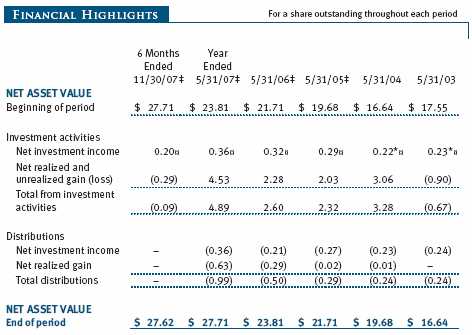
Unaudited
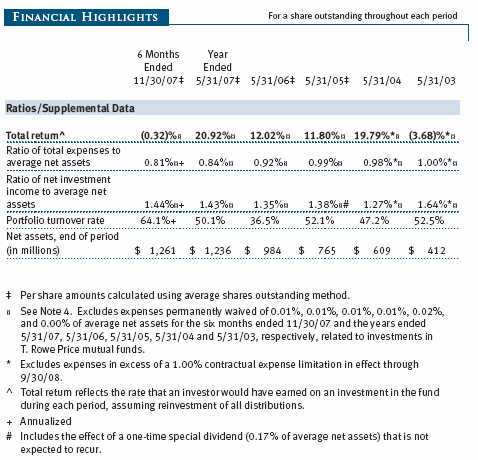
The accompanying notes are an integral part of these financial statements.
Unaudited



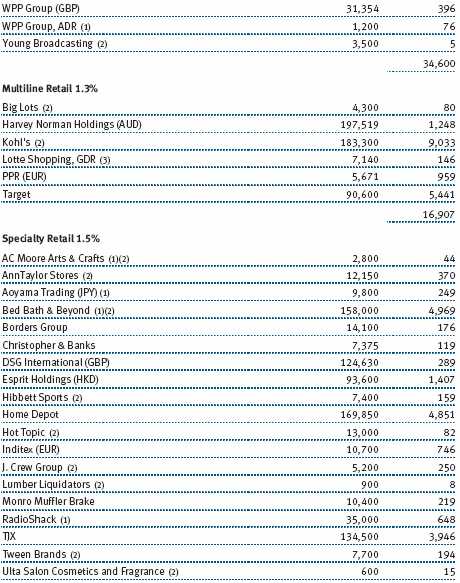
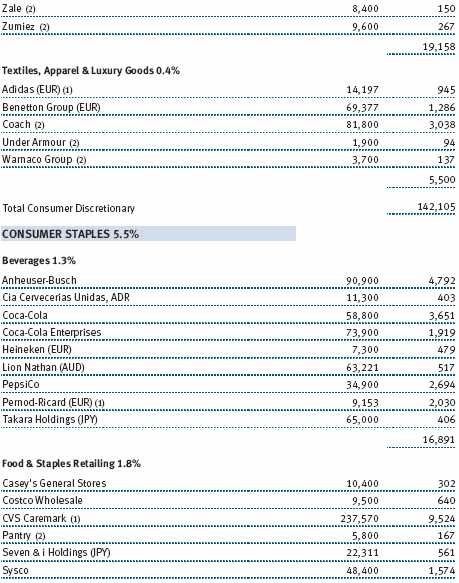


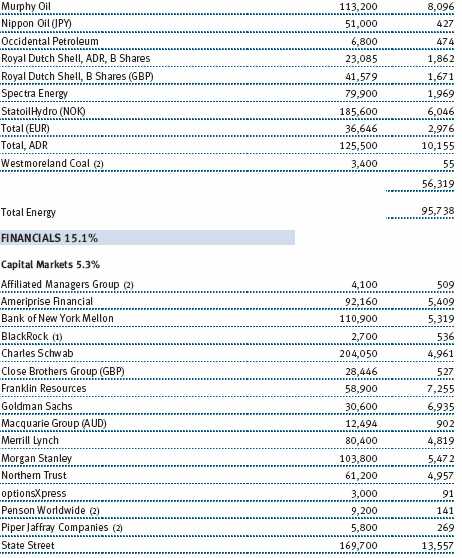

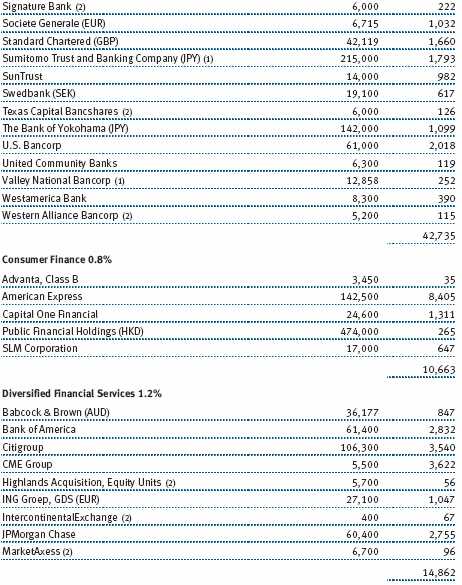


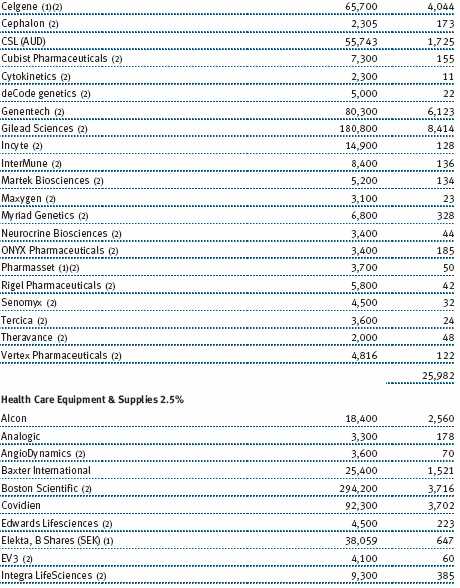

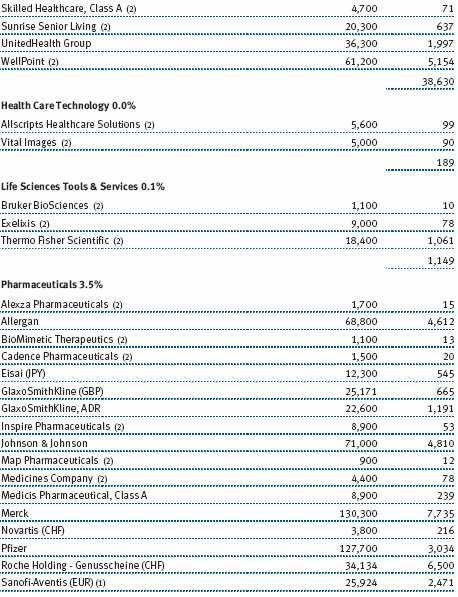
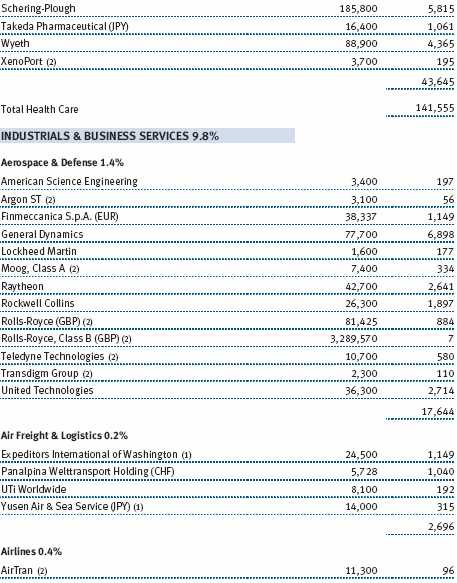
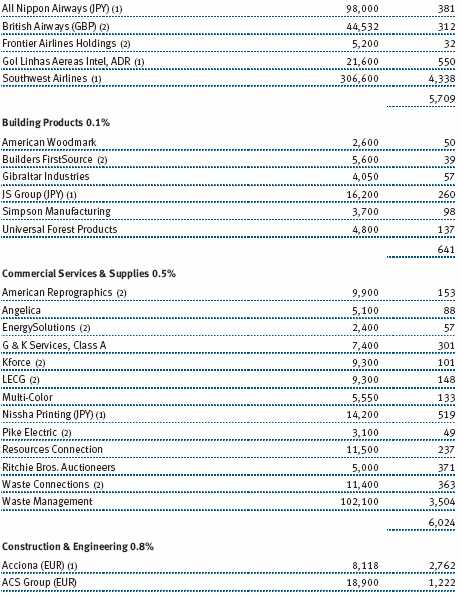



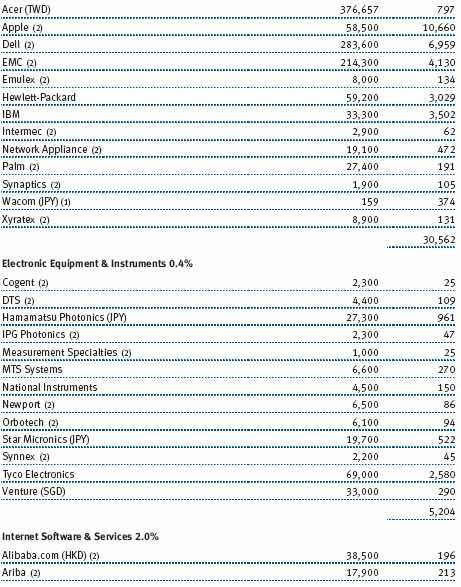

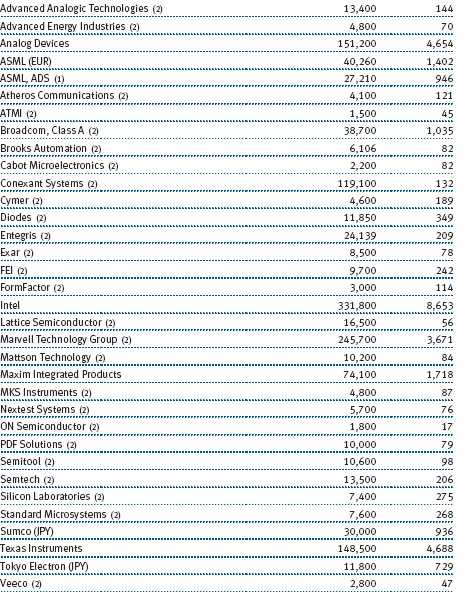
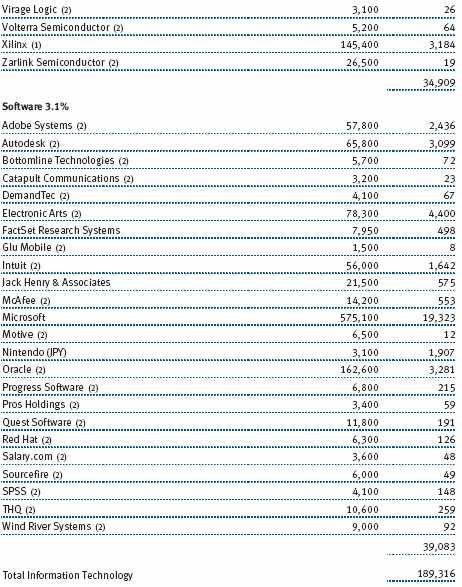
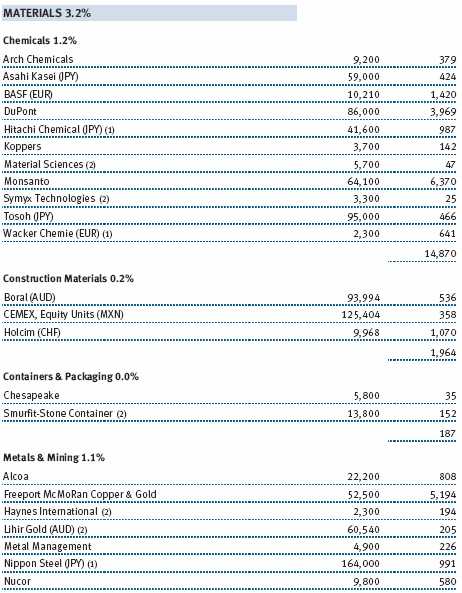


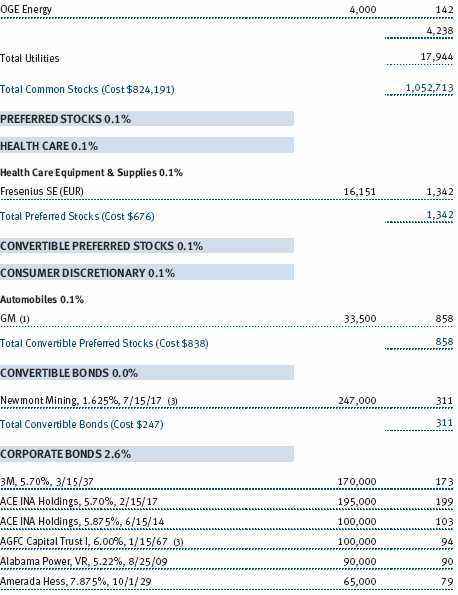




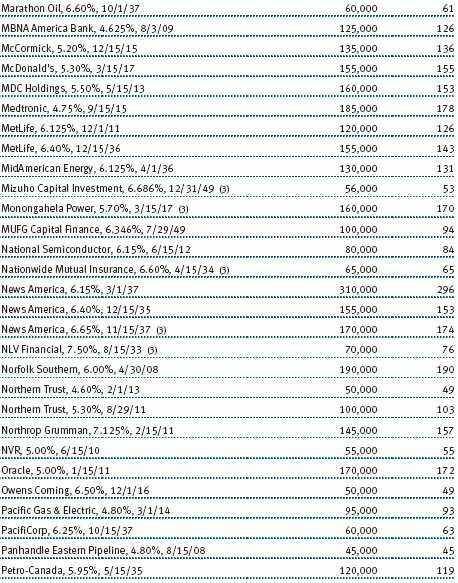
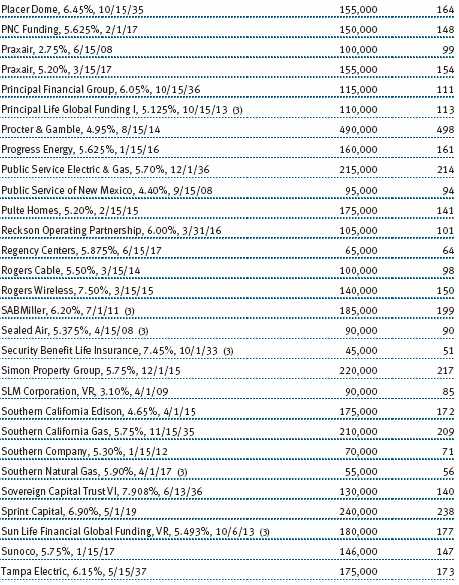
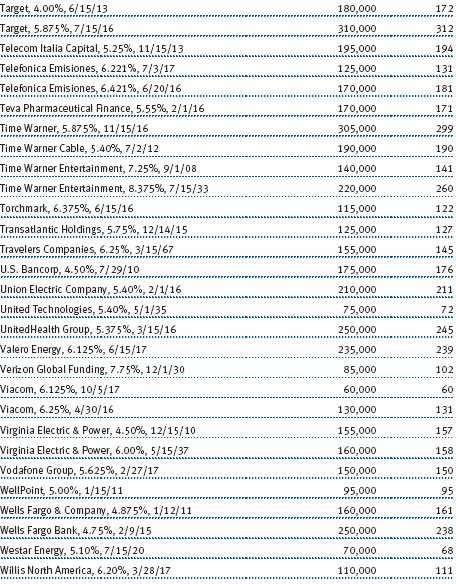

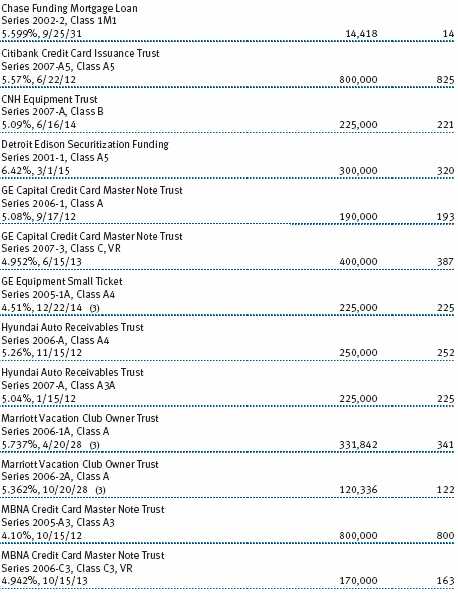



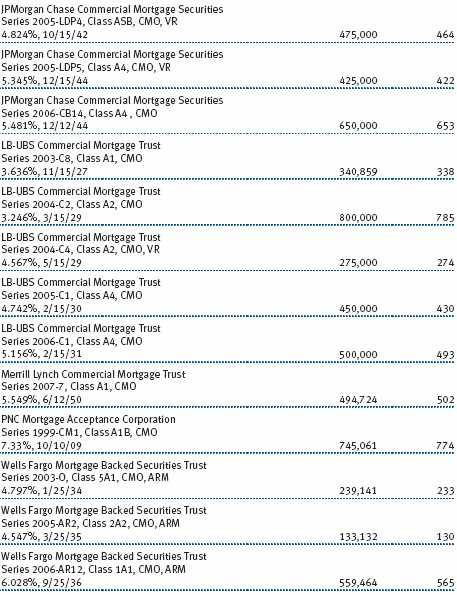
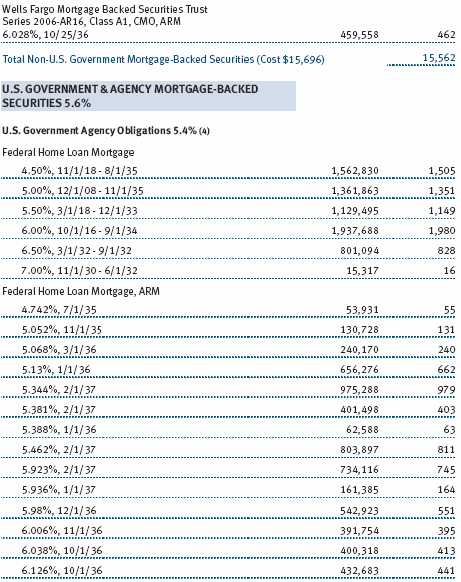
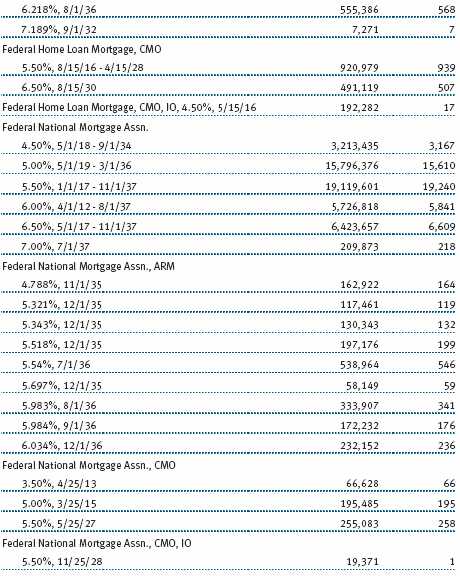
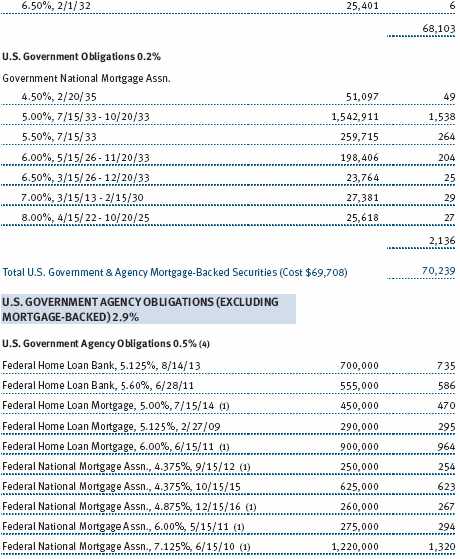
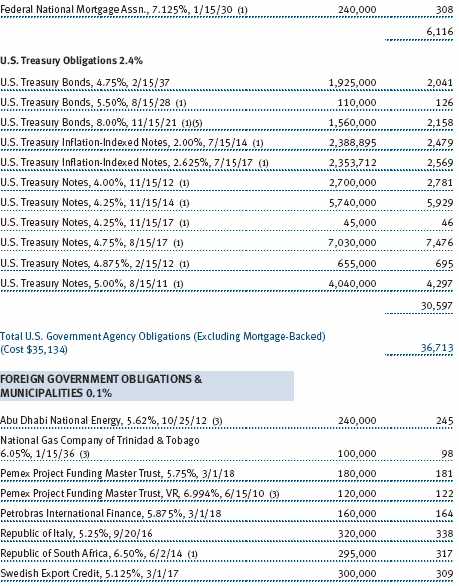

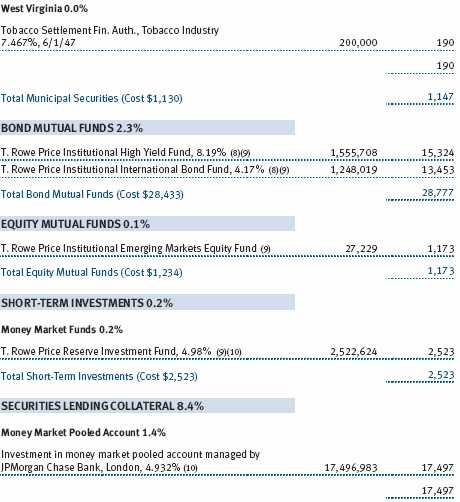
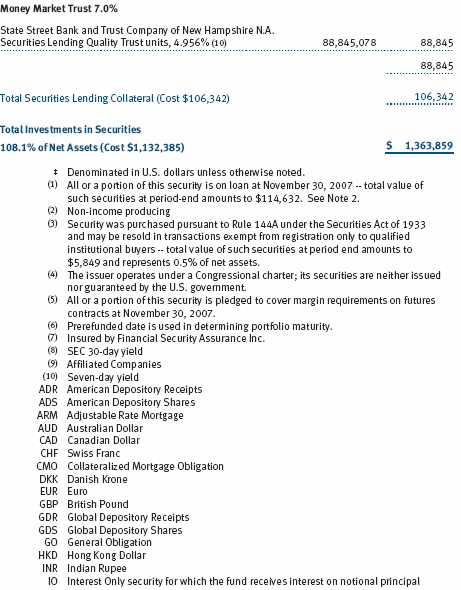
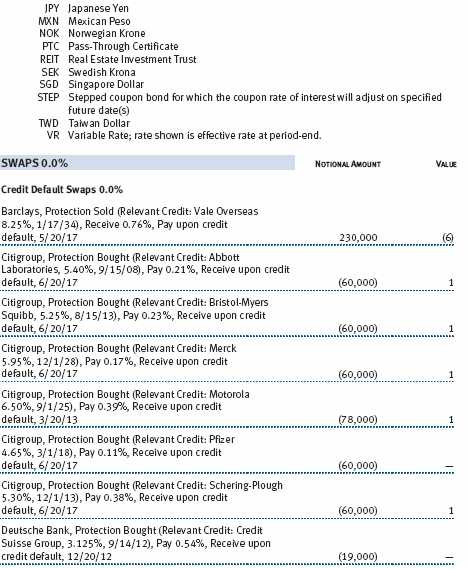
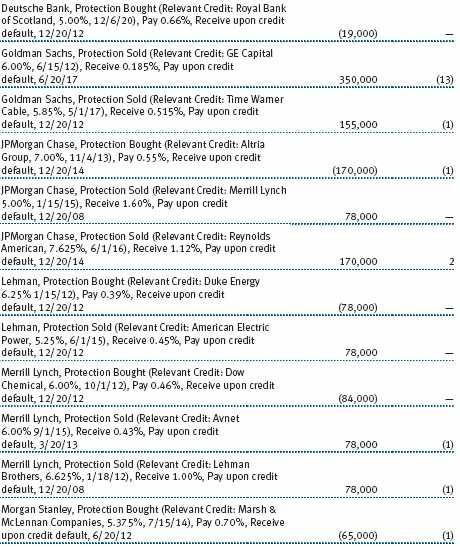


The accompanying notes are an integral part of these financial statements.

The accompanying notes are an integral part of these financial statements.
Unaudited
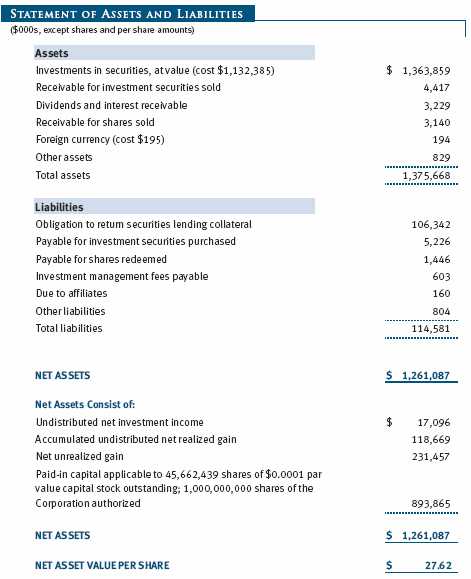
The accompanying notes are an integral part of these financial statements.
Unaudited
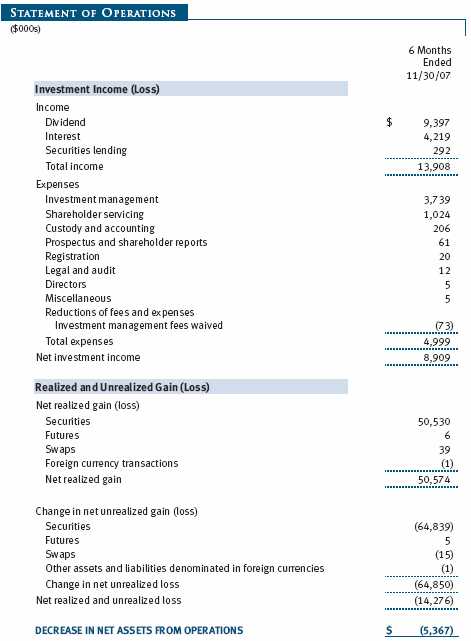
The accompanying notes are an integral part of these financial statements.
Unaudited
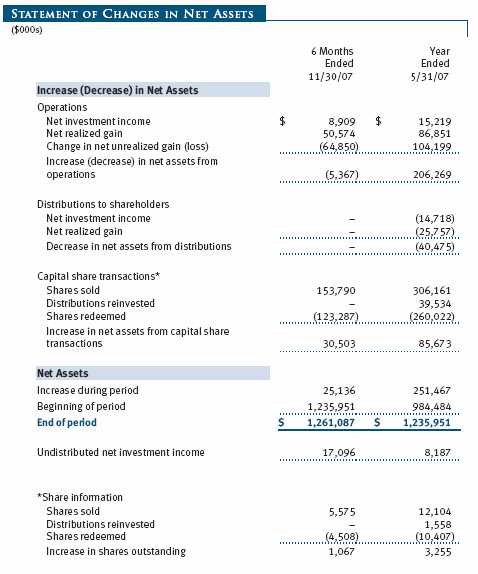
The accompanying notes are an integral part of these financial statements.
Unaudited
| NOTES TO FINANCIAL STATEMENTS |
NOTE 1 - SIGNIFICANT ACCOUNTING POLICIES
T. Rowe Price Personal Strategy Funds, Inc. (the corporation), is registered under the Investment Company Act of 1940 (the 1940 Act). The Personal Strategy Growth Fund (the fund), a diversified, open-end management investment company, is one portfolio established by the corporation. The fund commenced operations on July 29, 1994. The fund seeks the highest total return over time consistent with a primary emphasis on capital growth and a secondary emphasis on income. The fund pursues this objective by investing in a diversified portfolio typically consisting of about 80% stocks and 20% bonds and money market securities.
The accompanying financial statements were prepared in accordance with accounting principles generally accepted in the United States of America, which require the use of estimates made by fund management. Fund management believes that estimates and security valuations are appropriate; however, actual results may differ from those estimates, and the security valuations reflected in the financial statements may differ from the value the fund ultimately realizes upon sale of the securities.
Valuation The fund values its investments and computes its net asset value per share at the close of the New York Stock Exchange (NYSE), normally 4 p.m. ET, each day that the NYSE is open for business. Equity securities listed or regularly traded on a securities exchange or in the over-the-counter (OTC) market are valued at the last quoted sale price or, for certain markets, the official closing price at the time the valuations are made, except for OTC Bulletin Board securities, which are valued at the mean of the latest bid and asked prices. A security that is listed or traded on more than one exchange is valued at the quotation on the exchange determined to be the primary market for such security. Listed securities not traded on a particular day are valued at the mean of the latest bid and asked prices for domestic securities and the last quoted sale price for international securities.
Debt securities are generally traded in the over-the-counter market. Securities with original maturities of one year or more are valued at prices furnished by dealers who make markets in such securities or by an independent pricing service, which considers yield or price of bonds of comparable quality, coupon, maturity, and type, as well as prices quoted by dealers who make markets in such securities.
Securities with original maturities of less than one year are valued at amortized cost in local currency, which approximates fair value when combined with accrued interest.
Investments in mutual funds are valued at the mutual fund’s closing net asset value per share on the day of valuation. Financial futures contracts are valued at closing settlement prices. Swap agreements are valued at prices furnished by dealers who make markets in such securities or by an independent pricing service.
Other investments, including restricted securities, and those for which the above valuation procedures are inappropriate or are deemed not to reflect fair value are stated at fair value as determined in good faith by the T. Rowe Price Valuation Committee, established by the fund’s Board of Directors.
Most foreign markets close before the close of trading on the NYSE. If the fund determines that developments between the close of a foreign market and the close of the NYSE will, in its judgment, materially affect the value of some or all of its portfolio securities, which in turn will affect the fund’s share price, the fund will adjust the previous closing prices to reflect the fair value of the securities as of the close of the NYSE, as determined in good faith by the T. Rowe Price Valuation Committee, established by the fund’s Board of Directors. A fund may also fair value securities in other situations, such as when a particular foreign market is closed but the fund is open. In deciding whether to make fair value adjustments, the fund reviews a variety of factors, including developments in foreign markets, the performance of U.S. securities markets, and the performance of instruments trading in U.S. markets that represent foreign securities and baskets of foreign securities. The fund uses outside pricing services to provide it with closing market prices and information used for adjusting those prices. The fund cannot predict when and how often it will use closing prices and when it will adjust those prices to reflect fair value. As a means of evaluating its fair value process, the fund routinely compares closing market prices, the next day’s opening prices in the same markets, and adjusted prices.
Currency Translation Assets, including investments, and liabilities denominated in foreign currencies are translated into U.S. dollar values each day at the prevailing exchange rate, using the mean of the bid and asked prices of such currencies against U.S. dollars as quoted by a major bank. Purchases and sales of securities, income, and expenses are translated into U.S. dollars at the prevailing exchange rate on the date of the transaction. The effect of changes in foreign currency exchange rates on realized and unrealized security gains and losses is reflected as a component of security gains and losses.
Rebates Subject to best execution, the fund may direct certain security trades to brokers who have agreed to rebate a portion of the related brokerage commission to the fund in cash. Commission rebates are reflected as realized gain on securities in the accompanying financial statements and totaled $15,000 for the six months ended November 30, 2007.
Investment Transactions, Investment Income, and Distributions Income and expenses are recorded on the accrual basis. Premiums and discounts on debt securities are amortized for financial reporting purposes. Inflation adjustments to the principal amount of inflation-indexed bonds are reflected as interest income. Dividends received from mutual fund investments are reflected as dividend income; capital gain distributions are reflected as realized gain/loss. Dividend income and capital gain distributions are recorded on the ex-dividend date. Income tax-related interest and penalties, if incurred, would be recorded as income tax expense. Investment transactions are accounted for on the trade date. Realized gains and losses are reported on the identified cost basis. Payments (“variation margin”) made or received to settle the daily fluctuations in the value of futures contracts are recorded as unrealized gains or losses until the contracts are closed. Unsettled variation margin on futures contracts is reflected as other assets or liabilities, and unrealized gains and losses on futures contracts are reflected as the change in net unrealized gain or loss in the accompanying financial statements. Net periodic receipts or payments required by swaps are accrued daily and recorded as realized gain or loss in the accompanying financial statements. Fluctuations in the fair value of swaps are reflected in the change in net unrealized gain or loss and are reclassified to realized gain or loss upon termination prior to maturity. Paydown gains and losses are recorded as an adjustment to interest income. Distributions to shareholders are recorded on the ex-dividend date. Income distributions are declared and paid on an annual basis. Capital gain distributions, if any, are declared and paid by the fund, typically on an annual basis.
New Accounting Pronouncements Effective November 30, 2007, the fund adopted Financial Accounting Standards Board (FASB) Interpretation No. 48 (FIN 48), Accounting for Uncertainty in Income Taxes, a clarification of FASB Statement No. 109, Accounting for Income Taxes. FIN 48 establishes financial accounting and disclosure requirements for recognition and measurement of tax positions taken or expected to be taken on an income tax return. The adoption of FIN 48 had no impact on the fund’s net assets or results of operations.
In September 2006, the FASB released the Statement of Financial Accounting Standard No. 157 (FAS 157), Fair Value Measurements. FAS 157 clarifies the definition of fair value and establishes the framework for measuring fair value, as well as proper disclosure of this methodology in the financial statements. It will be effective for the fund’s fiscal year beginning June 1, 2008. Management is evaluating the effects of FAS 157; however, it is not expected to have a material impact on the fund’s net assets or results of operations.
NOTE 2 - INVESTMENT TRANSACTIONS
Consistent with its investment objective, the fund engages in the following practices to manage exposure to certain risks or to enhance performance. The investment objective, policies, program, and risk factors of the fund are described more fully in the fund’s prospectus and Statement of Additional Information.
Restricted Securities The fund may invest in securities that are subject to legal or contractual restrictions on resale. Prompt sale of such securities at an acceptable price may be difficult due to substantial delays and additional costs related to their restrictions.
Futures Contracts During the six months ended November 30, 2007, the fund was a party to futures contracts, which provide for the future sale by one party and purchase by another of a specified amount of a specific financial instrument at an agreed upon price, date, time, and place. Risks arise from possible illiquidity of the futures market and from movements in security values and/or interest rates.
Swaps During the six months ended November 30, 2007, the fund was a party to interest rate swaps under which it is obligated to exchange cash flows based on the difference between specified interest rates applied to a notional principal amount for a specified period of time. Risks arise from the possible inability of counterparties to meet the terms of their agreements and from movements in interest rates. During the six months ended November 30, 2007, the fund was a party to credit default swaps under which it buys or sells credit protection against a defined-issuer credit event. Upon a defined-issuer credit event, the fund is required to either deliver the notional amount of the contract in cash and take delivery of the relevant credit or deliver cash approximately equal to the notional amount of the contract less market value of the relevant credit at the time of the credit event. Risks arise from the possible inability of counterparties to meet the terms of their agreements and from changes in creditworthiness of the relevant underlying issuer.
TBA Purchase Commitments During the six months ended November 30, 2007, the fund entered into to be announced (TBA) purchase commitments, pursuant to which it agrees to purchase mortgage-backed securities for a fixed unit price, with payment and delivery at a scheduled future date beyond the customary settlement period for that security. With TBA transactions, the particular securities to be delivered are not identified at the trade date; however, delivered securities must meet specified terms, including issuer, rate, and mortgage term, and be within industry-accepted “good delivery” standards. The fund generally enters into TBAs with the intention of taking possession of the underlying mortgage securities. Until settlement, the fund maintains cash reserves and liquid assets sufficient to settle its TBAs.
Securities Lending The fund lends its securities to approved brokers to earn additional income. It receives as collateral cash and U.S. government securities valued at 102% to 105% of the value of the securities on loan. Cash collateral is invested in money market pooled accounts managed by the fund’s lending agents in accordance with investment guidelines approved by fund management. Collateral is maintained over the life of the loan in an amount not less than the value of loaned securities, as determined at the close of fund business each day; any additional collateral required due to changes in security values is delivered to the fund the next business day. Although risk is mitigated by the collateral, the fund could experience a delay in recovering its securities and a possible loss of income or value if the borrower fails to return the securities. Securities lending revenue recognized by the fund consists of earnings on invested collateral and borrowing fees, net of any rebates to the borrower and compensation to the lending agent. At November 30, 2007, the value of loaned securities was $114,632,000; aggregate collateral consisted of $106,342,000 in money market pooled accounts and U.S. government securities valued at $10,500,000.
Other Purchases and sales of portfolio securities, other than short-term and U.S. government securities, aggregated $315,215,000 and $262,354,000, respectively, for the six months ended November 30, 2007. Purchases and sales of U.S. government securities aggregated $132,242,000 and $130,996,000, respectively, for the six months ended November 30, 2007.
NOTE 3 - FEDERAL INCOME TAXES
No provision for federal income taxes is required since the fund intends to continue to qualify as a regulated investment company under Subchapter M of the Internal Revenue Code and distribute to shareholders all of its taxable income and gains. Federal income tax regulations differ from generally accepted accounting principles; therefore, distributions determined in accordance with tax regulations may differ in amount or character from net investment income and realized gains for financial reporting purposes. Financial reporting records are adjusted for permanent book/tax differences to reflect tax character. Financial records are not adjusted for temporary differences. The amount and character of tax-basis distributions and composition of net assets are finalized at fiscal year-end; accordingly, tax-basis balances have not been determined as of November 30, 2007.
At November 30, 2007, the cost of investments for federal income tax purposes was $1,132,385,000. Net unrealized gain aggregated $231,457,000 at period-end, of which $272,415,000 related to appreciated investments and $40,958,000 related to depreciated investments.
NOTE 4 - RELATED PARTY TRANSACTIONS
The fund is managed by T. Rowe Price Associates, Inc. (the manager or Price Associates), a wholly owned subsidiary of T. Rowe Price Group, Inc. The investment management agreement between the fund and the manager provides for an annual investment management fee, which is computed daily and paid monthly. The fee consists of an individual fund fee, equal to 0.30% of the fund’s average daily net assets, and a group fee. The group fee rate is calculated based on the combined net assets of certain mutual funds sponsored by Price Associates (the group) applied to a graduated fee schedule, with rates ranging from 0.48% for the first $1 billion of assets to 0.285% for assets in excess of $220 billion. The fund’s group fee is determined by applying the group fee rate to the fund’s average daily net assets. At November 30, 2007, the effective annual group fee rate was 0.30%.
The fund is also subject to a contractual expense limitation through September 30, 2008. During the limitation period, the manager is required to waive its management fee and reimburse the fund for any expenses, excluding interest, taxes, brokerage commissions, and extraordinary expenses, that would otherwise cause the fund’s ratio of annualized total expenses to average net assets (expense ratio) to exceed its expense limitation of 1.00%. The fund is required to repay the manager for expenses previously reimbursed and management fees waived to the extent the fund’s net assets have grown or expenses have declined sufficiently to allow repayment without causing the fund’s expense ratio to exceed its expense limitation.
However, no repayment will be made more than three years after the date of any reimbursement or waiver or later than September 30, 2010. At November 30, 2007, there were no amounts subject to repayment. For the six months ended November 30, 2007, the fund operated below its expense limitation.
In addition, the fund has entered into service agreements with Price Associates and two wholly owned subsidiaries of Price Associates (collectively, Price). Price Associates computes the daily share price and provides certain other administrative services to the fund. T. Rowe Price Services, Inc., provides shareholder and administrative services in its capacity as the fund’s transfer and dividend disbursing agent. T. Rowe Price Retirement Plan Services, Inc., provides subaccounting and recordkeeping services for certain retirement accounts invested in the fund. For the six months ended November 30, 2007, expenses incurred pursuant to these service agreements were $92,000 for Price Associates, $324,000 for T. Rowe Price Services, Inc., and $439,000 for T. Rowe Price Retirement Plan Services, Inc. The total amount payable at period-end pursuant to these service agreements is reflected as Due to Affiliates in the accompanying financial statements.
The fund may invest in the T. Rowe Price Reserve Investment Fund and the T. Rowe Price Government Reserve Investment Fund (collectively, the T. Rowe Price Reserve Investment Funds), open-end management investment companies managed by Price Associates and affiliates of the fund. The T. Rowe Price Reserve Investment Funds are offered as cash management options to mutual funds, trusts, and other accounts managed by Price Associates and/or its affiliates, and are not available for direct purchase by members of the public. The T. Rowe Price Reserve Investment Funds pay no investment management fees.
The fund may invest in certain T. Rowe Price Institutional funds (underlying Institutional funds) as a means of gaining efficient and cost-effective exposure to certain markets. The underlying Institutional funds are open-end management investment companies managed by Price Associates and T. Rowe Price International, Inc. (collectively, the Institutional managers), and are affiliates of the fund (reflected on the Affiliated Companies table). Each underlying Institutional fund pays an annual all-inclusive management and administrative fee to the Institutional managers. To ensure that T. Rowe Price Personal Strategy Growth Fund does not incur duplicate fees for its assets invested in the underlying Institutional funds, each Institutional manager has agreed to reduce its management fee charged to the fund. Accordingly, the accompanying Statement of Operations includes management fees permanently waived pursuant to these agreements. Fee rates and amount s waived related to shares of the underlying Institutional funds for the six months ended November 30, 2007, are as follows:

| INFORMATION ON PROXY VOTING POLICIES, PROCEDURES, AND RECORDS |
A description of the policies and procedures used by T. Rowe Price funds and portfolios to determine how to vote proxies relating to portfolio securities is available in each fund’s Statement of Additional Information, which you may request by calling 1-800-225-5132 or by accessing the SEC’s Web site, www.sec.gov. The description of our proxy voting policies and procedures is also available on our Web site, www.troweprice.com. To access it, click on the words “Company Info” at the top of our homepage for individual investors. Then, in the window that appears, click on the “Proxy Voting Policy” navigation button in the top left corner.
Each fund’s most recent annual proxy voting record is available on our Web site and through the SEC’s Web site. To access it through our Web site, follow the directions above, then click on the words “Proxy Voting Record” at the bottom of the Proxy Voting Policy page.
| HOW TO OBTAIN QUARTERLY PORTFOLIO HOLDINGS |
The fund files a complete schedule of portfolio holdings with the Securities and Exchange Commission for the first and third quarters of each fiscal year on Form N-Q. The fund’s Form N-Q is available electronically on the SEC’s Web site (www.sec.gov); hard copies may be reviewed and copied at the SEC’s Public Reference Room, 450 Fifth St. N.W., Washington, DC 20549. For more information on the Public Reference Room, call 1-800-SEC-0330.
Item 2. Code of Ethics.
A code of ethics, as defined in Item 2 of Form N-CSR, applicable to its principal executive officer, principal financial officer, principal accounting officer or controller, or persons performing similar functions is filed as an exhibit to the registrant’s annual Form N-CSR. No substantive amendments were approved or waivers were granted to this code of ethics during the registrant’s most recent fiscal half-year.
Item 3. Audit Committee Financial Expert.
Disclosure required in registrant’s annual Form N-CSR.
Item 4. Principal Accountant Fees and Services.
Disclosure required in registrant’s annual Form N-CSR.
Item 5. Audit Committee of Listed Registrants.
Not applicable.
Item 6. Schedule of Investments.
Not applicable. The complete schedule of investments is included in Item 1 of this Form N-CSR.
Item 7. Disclosure of Proxy Voting Policies and Procedures for Closed-End Management Investment Companies.
Not applicable.
Item 8. Portfolio Managers of Closed-End Management Investment Companies.
Not applicable.
Item 9. Purchases of Equity Securities by Closed-End Management Investment Company and Affiliated Purchasers.
Not applicable.
Item 10. Submission of Matters to a Vote of Security Holders.
Not applicable.
Item 11. Controls and Procedures.
(a) The registrant’s principal executive officer and principal financial officer have evaluated the registrant’s disclosure controls and procedures within 90 days of this filing and have concluded that the registrant’s disclosure controls and procedures were effective, as of that date, in ensuring that information required to be disclosed by the registrant in this Form N-CSR was recorded, processed, summarized, and reported timely.
(b) The registrant’s principal executive officer and principal financial officer are aware of no change in the registrant’s internal control over financial reporting that occurred during the registrant’s second fiscal quarter covered by this report that has materially affected, or is reasonably likely to materially affect, the registrant’s internal control over financial reporting.
Item 12. Exhibits.(a)(1) The registrant’s code of ethics pursuant to Item 2 of Form N-CSR is filed with the registrant’s annual Form N-CSR.
(2) Separate certifications by the registrant's principal executive officer and principal financial officer, pursuant to Section 302 of the Sarbanes-Oxley Act of 2002 and required by Rule 30a-2(a) under the Investment Company Act of 1940, are attached.
(3) Written solicitation to repurchase securities issued by closed-end companies: not applicable.
(b) A certification by the registrant's principal executive officer and principal financial officer, pursuant to Section 906 of the Sarbanes-Oxley Act of 2002 and required by Rule 30a-2(b) under the Investment Company Act of 1940, is attached.
| | |
SIGNATURES |
| |
| | Pursuant to the requirements of the Securities Exchange Act of 1934 and the Investment |
| Company Act of 1940, the registrant has duly caused this report to be signed on its behalf by the |
| undersigned, thereunto duly authorized. |
| |
| T. Rowe Price Personal Strategy Funds, Inc. |
| |
| |
| |
| By | /s/ Edward C. Bernard |
| | Edward C. Bernard |
| | Principal Executive Officer |
| |
| Date | January 16, 2008 |
| |
| |
| |
| | Pursuant to the requirements of the Securities Exchange Act of 1934 and the Investment |
| Company Act of 1940, this report has been signed below by the following persons on behalf of |
| the registrant and in the capacities and on the dates indicated. |
| |
| |
| By | /s/ Edward C. Bernard |
| | Edward C. Bernard |
| | Principal Executive Officer |
| |
| Date | January 16, 2008 |
| |
| |
| |
| By | /s/ Joseph A. Carrier |
| | Joseph A. Carrier |
| | Principal Financial Officer |
| |
| Date | January 16, 2008 |











































































